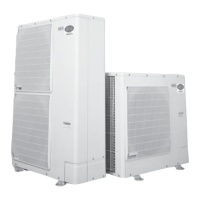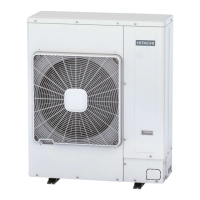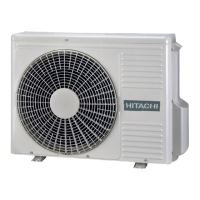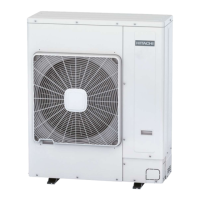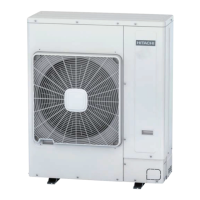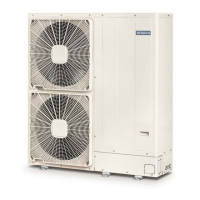9 Piping work and refrigerant charge
Copper pipes, sizes and connection
TCGB0136 rev.1 - 05/2021
90
4 indoor units system
(mm)
Outdoor Unit HP
Pipe Size (A)
Branch pipe
Gas Liquid
4 / 5 / 6 Ø15.88 Ø9.52 E-102SN4
(mm)
Total Indoor Unit capacity after
branch pipe 1+2 or 3+4
Pipe Size (B, C)
Branch line
Indoor Unit
capacity
Pipe Size (D, E, F, G)
Gas Liquid Gas Liquid
≤ 1.5 HP Ø12.70 Ø6.35 E-102SN4 ≤ 1.5 HP Ø12.70 Ø6.35
from 1.8 to 2.0 HP Ø15.88 Ø6.35 E-102SN4 1.8/2.0HP Ø15.88 Ø6.35
≥ 2.3 HP Ø15.88 Ø9.52 E-102SN4 ≥ 2.3 HP Ø15.88 Ø9.52
? NOTE
Recomendedcapacityratiofor4indoorunitssystem:
Capacityindoorunit1+2/Capacity1+2+3+4<60%
Capacityindoorunit3+4/Capacity1+2+3+4<60%
Ifthecapacityratioofbranchofindoorunits1and2isbiggerthan60%oftotalcapacityofthesystemorcapacityratioofbranchof
indoorunit3and4isbiggerthan60%oftotalcapacityofthesystem,pleasecontactwithyourHitachiDealerorHitachiCustomerService
Department.
9.3 Copper pipes, sizes and connection
9.3.1 Copper pipes and sizes
1 Prepare locally-supplied copper pipes.
2 Select the pipe size of a suitable thickness and material. Use the table below to select the required piping.
Nominal diameter
(according to European Standards EN-12735-1)
Minimum thickness (mm) Copper type
(mm) (in.)
Ø6.35 1/4 0.80 Coil (Soft)
Ø9.52 3/8 0.80 Coil (Soft)
Ø12.70 1/2 0.80 Coil (Soft)
Ø15.87 5/8 1.00 Straight lengths (half hard) / Coil (Soft)
Ø19.05 3/4 1.00 Coil (Soft)
3 Select clean copper pipes. Make sure there is no dust and moisture inside. Blow the inside of the pipes through with
oxygen-free nitrogen to remove any dust and foreign materials before connecting pipes.
4 After connecting the refrigerant piping, seal the open space between the knockout hole and refrigerant pipes by using
insulation material as shown below:
Insulation (Field supplied)
Insulation (Field supplied).
Field-supplied refrigeration piping
Bracket or tape (Field supplied)

